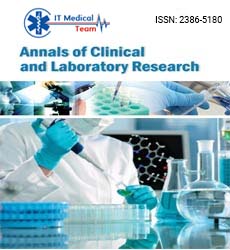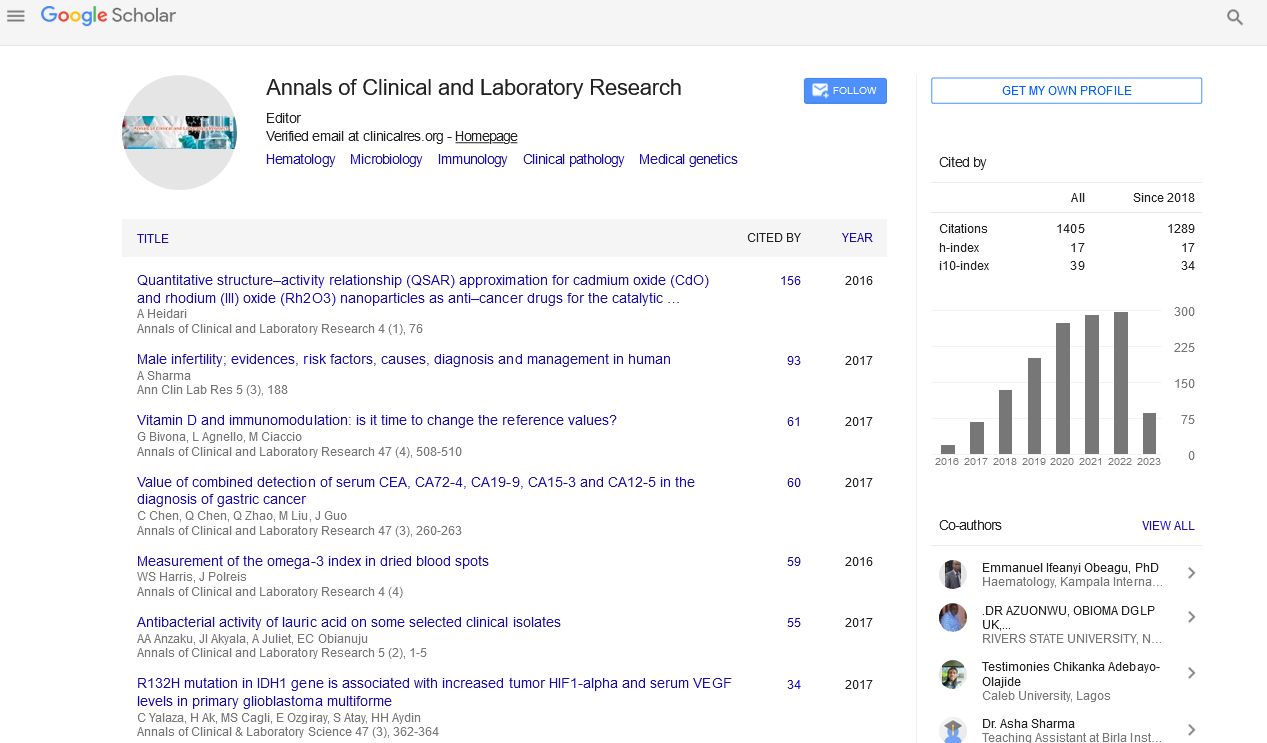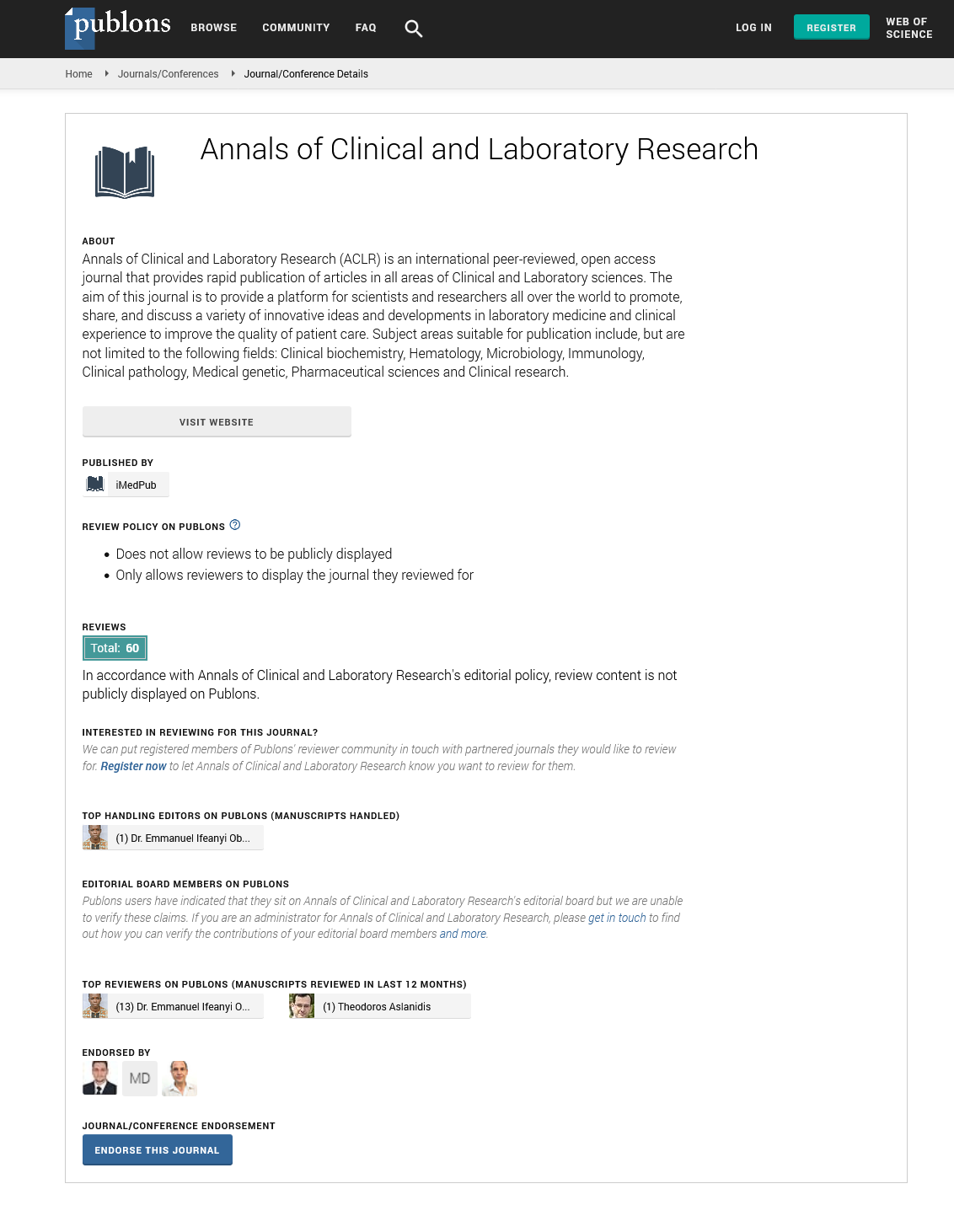Keywords
Alere HIV Combo, Alere Determine HIV-1/2 Combo, HIV rapid test HIV primary or early infection, Point-of-care HIV test
Introduction
Early diagnosis of acute human immunodeficiency virus (HIV) infections by rapid screening tests allows quick information of HIV status in patients presenting with unspecific symptoms, AIDSdefining illnesses or for the prevention of spread in dedicated primary care health centres. Particularly, individuals with an acute or early primary HIV infection have high viral loads, making them highly contagious.
Rapid tests are often used at health care facilities to guide management [1]. For HIV infections rapid test systems are available since 1996 [2]. Generally, positive results by test strips analyses are obtained in late stage of HIV infection, where only antibodies are present. However, the detection of acute or early HIV infections with such systems is still a challenge [3].
In 2009 the first 4th generation rapid test was introduced with the combined determination of anti-HIV antibodies and p24 antigen. The Alere Determine HIV-1/2 Ag/Ab Combo test is a lateral flow rapid assay with anti-HIV-1, anti-HIV-2 and p24 antigen. Infections can be detected five days earlier than with third generation assays [4,5]. However, cases of false negative screening results by the Determine HIV-1/2 Ag/Ab Combo test were described in early manifestations of infections [6,7]. Thus, Alere recently developed a new rapid HIV Combo assay with the goal to improve the detection of p24 antigen.
The pilot study should elucidate the usefulness of the new 4th generation Alere HIV Combo as HIV-screening test. It is compared with the Alere Determine HIV-1/ Ag/Ab Combo and verified with reference methods of Western blot and RNA determination. Particular interest will be on the capability to detect acute or early primary infections which contain only p24-antigen.
Methods
HIV-screening with samples from our tertiary health care institution was performed on Abbott Architect i2000SR with a 4th generation HIV-1/2 and p24 Combo chemiluminescence assay. Reactive results were confirmed according to the Swiss health authorities [8] by the Swiss reference laboratory at the National Centre of Retroviruses, University of Zurich, Switzerland. Samples were stored at -20°C and negative and true positive samples were chosen for comparison with both assays: Alere Determine HIV-1/2 Ag/Ab Combo (CE-marked, REF 7D2646) and new Alere HIV Combo (CE-marked, REF 7D2846). Tests were performed as described by the manufacturer. Briefly, 50 μl of serum sample was applied onto the sample pad, and results were read at the reaction pad at 20 min to 40 min. No invalid results were seen.
Informed consent of the patients was not needed, as all samples were from routine testing, and were re-tested anonymously in this study. This is in accordance with the Ethic Committee of our institution. Results were not revealed to the physician and thus patient management did not change due to these results.
Results
Thirty-eight serum samples (Table 1), of which 23 had been confirmed positive by the reference laboratory, were compared with both rapid assays: the new Alere HIV Combo (REF 7D2846) and Alere Determine HIV-1/2 Ag/Ab Combo (REF 7D2646). All positive samples were from patients who were newly diagnosed and not under Highly Active Anti-Retroviral Therapy (HAART), except one with HIV-2.
| |
Number of samples |
age median (years) |
f/m * |
| Established HIV-1 |
15 |
46 (min 29, max 66) |
7/8 |
| Established HIV-2 |
2 |
40 (min 38, max 42) |
2/0 |
| Acute / early primary |
6 |
35 (min 26, max 60) |
1/5 |
| Borderline reactive |
5 |
55 (min 17, max 67) |
1/4 |
| Negative |
10 |
38 (min 18, max 79) |
5/5 |
Table 1: Number of samples tested and demographic data.
Fifteen samples of established old HIV-1 infections reacted correctly at the antibody sites with both rapid assays. However, on the p24-antigen pad no reaction appeared, although HIV- 1 viral loads were up to 1.3×106 copies/ml. Only one case with >107copies/ml showed a weak reaction with Alere Determine HIV-1/2 Ag/Ab (Table 2). This fail of reactivity was probably due to antibody-antigen complexes, as described by the manufacturer.
| Patient |
Determine Alere HIV-1/2 Ag/Ab Combo Ref. Nr. 7D2646 |
|
New Alere HIV combo Ref.Nr. 7D2846 |
|
Abbott Architect i2000SR |
|
NCR1) |
|
| |
anti-HIV-1 or HIV-2 Ab |
p24 Ag |
anti-HIV Ab |
p24 Ag |
anti-HIV-1/2 p24 Combo (cutoff S/CO <1) |
HIV western blot |
HIV RNA
(copies/ml) |
Clade |
| Anti HIV-1 antibodies |
|
|
|
| 1 |
pos |
neg |
pos |
neg |
632 |
HIV-1 |
363 |
A1 |
| 2 |
pos |
neg |
pos |
neg |
504 |
HIV-1 |
191024 |
A1 |
| 3 |
pos |
neg |
pos |
neg |
253 |
HIV-1 |
718 |
B |
| 4 |
pos |
neg |
pos |
neg |
486 |
HIV-1 |
4044 |
B |
| 5 |
pos |
neg |
pos |
neg |
919 |
HIV-1 |
29472 |
B |
| 6 |
pos |
neg |
pos |
neg |
321 |
HIV-1 |
75720 |
B |
| 7 |
pos |
neg |
pos |
neg |
678 |
HIV-1 |
92000 |
B |
| 8 |
pos |
very weak pos |
pos |
neg |
1142 |
HIV-1 |
>10000000 |
B |
| 9 |
pos |
neg |
pos |
neg |
873 |
HIV-1 |
23637 |
C |
| 10 |
pos |
neg |
pos |
neg |
839 |
HIV-1 |
23700 |
CRF01_AE |
| 11 |
pos |
neg |
pos |
neg |
633 |
HIV-1 |
26265 |
CRF01_AE |
| 12 |
pos |
neg |
pos |
neg |
313 |
HIV-1 |
1379981 |
CRF01_AE |
| 13 |
pos |
neg |
pos |
neg |
428 |
HIV-1 |
2537 |
CRF02_AG |
| 14 |
pos |
neg |
pos |
neg |
613 |
HIV-1 |
282000 |
CRF02_AG |
| 15 |
pos |
neg |
pos |
neg |
257 |
HIV-1 |
59572 |
D |
| Anti-HIV-2 antibodies |
|
|
|
| 16 |
pos |
neg |
pos |
neg |
83 |
HIV-2 |
PERT 911 nU RNA/ml = 17659 copies/ml |
|
| 17 |
pos |
neg |
pos |
neg |
- |
HIV-2 |
under HAART |
|
| p24-antigen only |
|
|
|
| 18 |
neg |
very weak pos |
neg |
weak pos |
49.1 |
no Ab |
1808956 |
B |
| 19 |
neg |
very weak pos |
very weak pos |
pos |
251 |
very weak pos HIV-1 Ab |
1983752 |
B |
| 20 |
neg |
very weak pos |
neg |
pos |
128 |
no Ab |
>10000000 |
B |
| 21 |
neg |
neg |
neg |
pos2) |
91 |
no Ab |
>10000000 |
C |
| 22 |
neg |
neg |
neg |
weak pos |
50.5 |
no Ab |
>10000000 |
CRF01_AE |
Table 2: Comparison of the new Alere HIV Combo with the Alere Determine HIV-1/2 Combo, and results of confirmatory assays from the reference laboratory
Only two samples with anti-HIV-2 antibodies could be tested, as patients with HIV-2 infections are very rare in our region. Both samples gave correct antibody bands with both Alere assays, but no p24-antigen reactivity
Six samples of patients with acute or early primary HIV-1 infection, with still absences of antibodies had HIV-1 viral loads of >1.8×106 up to >107 copies/ml. Alere Determine HIV-1/2 Ag/ Ab Combo (REF 7D2646) gave very weak positive reactions at the p24-antigen band in only three of six samples. These three samples were of HIV-1 clade B. The non-reactive samples were all non-B clades.
The new Alere HIV Combo (REF 7D2846) reacted well at the p24- antigen site with all six samples. Some reactions were slightly weaker than others, but still well visible. All tested HIV-1 clades - B, C, CRF01_AE and CRF02_AG - gave positive reactions.
Fifteen samples with negative HIV-status were analysed. Five of them reacted weakly, and 10 samples were negative with Abbott Architect HIV-1/2 Ag/Ab Combo. The weak reactive samples had been negative in the confirmation assays. Both Alere rapid assays gave negative results in all 15 cases, thus no false positive reaction was recorded.
Discussion
The European guidelines for prevention and control of HIV infections insist on the importance of developing new HIV testing strategies aimed at difficult-to-reach high-risk persons [1]. The problem of testing negative during the window-period between infection and the production of antibodies with antibodydetection based tests is still an issue. Since the introduction of the 4th generation rapid assay, more positive and earlier cases were detected [5]. However, failures with the p24-antigen reactivity in acute and early primary infections were alarmingly high [3,6]. A new rapid test became available – the new Alere HIV Combo, which we tested in comparison with the older one.
Our results with the Alere Determine HIV-1/2 Ag/Ab Combo showed good antibody reactivity, but some failures with the p24-antigen detection, as described by others [3,5,6]. Anti- HIV-1 or HIV-2 antibodies, when present, were detected, but the appearances of p24-antigen bands were rare. Particularly missing was the detection of p24-antigen in acute or early primary infections. Only samples with HIV-1 of clade B gave very weak reactions at the p24-antigen site, whereas non-B clade remained negative, thus missing 50% of our primary infections. B clade strains are prominent in Europe and United States, and non-B clades in Africa and South East Asia [9,10]. Nonetheless, 57% of our samples were of non-B clades, as by others [11], meaning that assays with low affinity to non-B types miss an important amount of infections even in our region.
Due to these unsatisfactory results, the manufacturer improved the test, introducing an additional pad on the test strip, with a non-revealed reagent, to disrupt antigen-antibody complexes and improving the antigen site. Our collective showed with the new Alere HIV Combo a test line with all the positive samples, i.e. either at the antibody site in established HIV infections, or at the p24-antigen site in acute or early primary cases.
Although the p24-antigen test line did not react when antibodies were present, probably still due to antigen-antibody complexes, this is not a problem in a screening assay, as the infection is already detected by the demonstration of the antibody reaction. However, further testing for confirmation by Western blot and determination of RNA follow when a reactive HIV test result is found [8]. More important was that the p24-antigen test line appeared in all cases of primary infections, where antibodies had not yet been produced. This was seen with the tested HIV-1 clades B, C, CRF01_AE and CRF02_AG, but whether this holds true for all clades will have to be further tested. Therefore, the new Alere HIV Combo detected all acute or early infections of our collective, even in samples from patients who became infected four weeks prior diagnosis.
The low number of samples of acute or early HIV infections which were available is a limitation to this study. Therefore, further multi-centre studies are needed to confirm these preliminary results.
Conclusion
Our pilot study confirms that Alere Determine HIV-1/2 Ag/Ab Combo detects mainly antibodies against HIV-1 and HIV-2, but rarely p24- antigens. The new Alere HIV Combo detected all positive samples either the anti-HIV-1/2 antibodies in established HIV infections or p24-antigen in acute or early infections.
Acknowledgement
Funding: No funding was received, except that the reagents for the Alere HIV Combo assay were provided for free by Alere Switzerland GmbH. No influence on the outcome of the results was exerted.
Ethical approval
Informed consent of the patients was not needed, as all samples were from routine testing, and were re-tested anonymously in this study. This is in accordance with the Ethic Committee of our institution. Results were not revealed to the physician and thus patient management did not change due to these results.
6899
References
- (2012) European Centre for Disease. Prev, Control. HIV testing: increasing uptake and effectiveness in the European Union, Stockholm: ECDC, Stockholm
- Ecker B, Vollenhofer S, Bares T, Schalkhammer T, Schinkinger M, et al. (1996) Overexpression and purification of a recombinant chimeric HIV type 2/HIV type 1 envelope peptide and application in an accelerated immunobased HIV type 1/2 antibody detection system (AIBS): a new rapid serological screening assay. AIDS Res Hum Retroviruses 12: 1081-1091.
- Rosenberg NE, Kamanga G, Phiri S, Nsona D, Pettifor A, et al. (2012) Detection of acute HIV infection: a field evaluation of the determine® HIV-1/2 Ag/Ab combo test. J Infect Dis 205: 528-534.
- Fiebig EW, Wright DJ, Rawal BD, Garrett PE, Schumacher RT, et al. (2003) Dynamics of HIV viremia and antibody seroconversion in plasma donors: implications for diagnosis and staging of primary HIV infection. AIDS 17: 1871-1879.
- Masciotra S, Luo W, Youngpairoj AS, Kennedy MS, Wells S, et al. (2013) Performance of the Alere Determine™ HIV-1/2 Ag/Ab Combo Rapid Test with specimens from HIV-1 seroconverters from the US and HIV-2 infected individuals from Ivory Coast. Clin Virol 1: e54-58.
- Lanzafame M, Zorzi A, Rigo F, Adami I, Del Bravo P, et al. (2013) Performance of Alere Determine HIV-1/2 Ag/Ab Combo rapid test for acute HIV infection: a case report. Infez Med 23:48-50.
- Faraoni S, Rocchetti A, Gotta F, Ruggiero T, Orofino G, et al. (2013) Evaluation of a rapid antigen and antibody combination test in acute HIV infection. J Clin Virol 57: 84-87.
- (2006) Bundesamt für Gesundheit: Das schweizerische HIV-Testkonzept – aktualisierte Übersicht über Technisches Konzept und Laborkonzept. Bulletin 51: 1022-1034.
- Vetter BN, Shah C, Huder JB, Böni J, Schüpbach J (2014) Use of reverse-transcriptase-based HIV-1 viral load assessment to confirm low viral loads in newly diagnosed patients in Switzerland. BMC Infect Dis 14: 84.
- Gao F, Morrison SG, Robertson DL, Thornton CL, Craig S, et al. (1996) Molecular cloning and analysis of functional envelope genes from human immunodeficiency virus type 1 sequence subtypes A through G. The WHO and NIAID Networks for HIV Isolation and Characterization. J Virol 70: 1651-1667.
- Schüpbach J, Bisset LR, Regenass S, Bürgisser P, Gorgievski M, et al. (2011) HIV Cohort Study: High specificity of line-immunoassay based algorithms for recent HIV-1 infection independent of viral subtype and stage of disease. BMC Infect Dis 11: 254.






